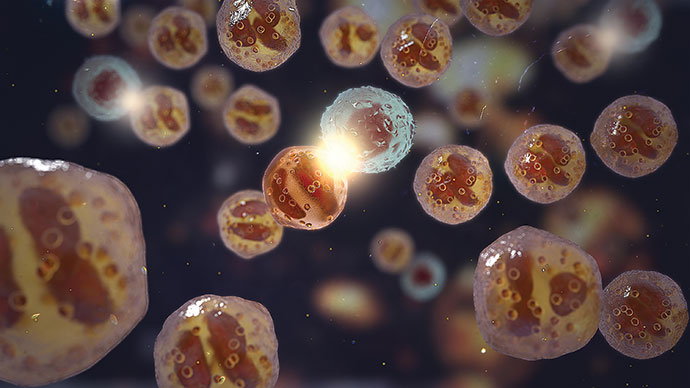Jeff Galvin, founder and CEO of Rockville, Maryland’s American Gene Technologies, speaks of cellular gene therapy with the zeal of an evangelist.
“I believe we’re on the eve of a gene and cell therapy revolution that will completely disrupt the traditional drug development industry and the economics of disease,” Galvin predicts, adding that emerging gene science offers the promise of “curing the incurable and treating the untreatable,” such as cancer and HIV.
It’s no coincidence that Galvin, a successful veteran of Silicon Valley, founded AGT in Maryland. The genetic breakthrough that undergirds AGT’s technology came straight from a laboratory at the National Institutes of Health in Bethesda. Galvin scooped it up for free.
“Maryland is a well from which all this free technology just springs and pours out for anyone to drink from. This is the epicenter,” Galvin tells Site Selection.
The Maryland/DC Metro region is home to one of the top life sciences clusters in the U.S., recently ranked No. 4 in the nation by Genetic Engineering and Biotechnology News, behind only Boston, San Francisco and New York/New Jersey. Maryland is home to 2,260 life sciences businesses from pharmaceutical giants AstraZeneca, Autolus and GlaxoSmithKline to homegrown startups such as Pikesville-based Alavita Health, a medical technologies company.
“This is a fantastic location,” says Sathya Elumalai, Alavita’s CEO. “We’re close to NIH and we’re close enough to FDA to feel as though they’re our partner."
The Place to Be
Access to federal institutions is but one of many valuable lures that have made Maryland the “epicenter” that Galvin speaks of.
Among them:
- Johns Hopkins University: Located in Baltimore, Johns Hopkins is the nation’s top academic recipient of research grant funding, and a proving ground for emerging biohealth companies such as Paragon Biosciences, founded in 1990 and recently acquired for $1.2 billion by Catalent Biologics.
“Paragon was part of the incubator program at Johns Hopkins in its early days as a company,” CEO Pete Buzy tells Site Selection. “This great opportunity to be part of such a strong scientific community provided us with the collaborative business ecosystem that small companies really need to grow.”
- Unmatched Talent: Top talent flows not only from Johns Hopkins and the University System of Maryland, but from the state’s 74 federal research labs, which provide a steady stream of post-doctoral scientists. Additionally, Maryland’s community colleges provide training for entry-level biotechnologists.
As a result, Maryland’s technology and science workforce ranked first in the nation in the Milken Institute’s 2018 State Technology and Science Index.
Kite, a biopharmaceutical company based in Santa Monica, California, announced plans in late April to build a new production facility in Maryland’s Frederick County, based largely on training opportunities for their employees at local colleges.
“One of the critical components in them coming was the ability to continuously train their employees on the latest and greatest technologies,” says Bret Schreiber, senior director of the Office of BioHealth & Life Sciences at the Maryland Department of Commerce.
- Cost of Living and Business: “If you want to open up the same business in Silicon Valley,” says AGT’s Galvin, “you need to raise two or three times as much money. The cost of everything is higher there, especially employees.”
Maryland’s cost of living, relative to San Francisco, New York and Boston, means lower salary requirements. Home prices in Maryland, for example, are comparable to those of studio apartments in the Bay area. Maryland’s stream of new college graduates helps to keep down costs, as well.
“We’re a small company,” says Sathya Elumalai of Alavita, “so we can’t necessarily afford to hire someone with 15 or 20 years of experience. We’re getting students from Johns Hopkins and turning them into experts.”
A State “Committed”
Gov. Larry Hogan recently called biopharma “the backbone of Maryland’s economy” during a forum at the Gaithersburg headquarters of AstraZeneca. As such, the state government offers a number of programs and incentives to boost the industry’s growth.

“Maryland is a well from which all this free technology just springs…”
The Maryland Biotechnology Investment Incentive Tax Credit allows for rebates equal to 50% of an eligible investment in qualified Maryland biotech companies, up to $250,000. Montgomery County, home to the state’s highest concentration of life sciences companies, offers a local biotech tax credit, the first of its kind in the nation.
In addition, the Maryland Technology Development Corporation facilitates technology transfer from academic and federal labs into the private sector with seed funding, technical assistance and entrepreneurial support programs. Early-stage equity is available through the Maryland Venture Fund.
“The state is committed,” says Galvin. “I’m a true believer in the future of gene and cell therapy in Maryland. You’re going to see that everybody’s going to have a footprint here.”
This Investment Profile was prepared under the auspices of Maryland Marketing Partnership. For more information, contact Sherri Diehl at 410-767-6835. On the web, go to www.commerce.maryland.gov

